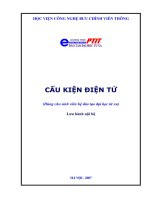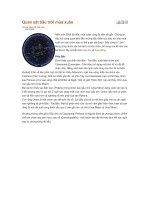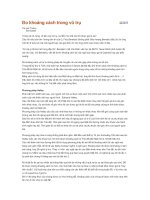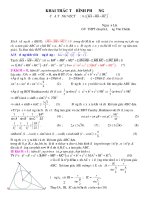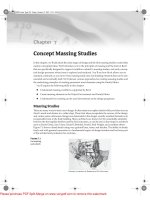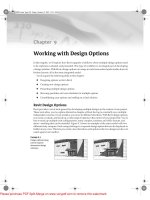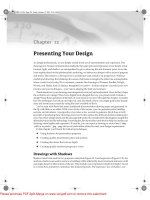Tài liệu Qualification Standard Reference Guide SEPTEMBER 2008 ppt
Bạn đang xem bản rút gọn của tài liệu. Xem và tải ngay bản đầy đủ của tài liệu tại đây (4.49 MB, 264 trang )
Mechanical
Systems
Qualification Standard
Reference Guide
SEPTEMBER 2008
This page is intentionally blank.
Table of Contents
i
LIST OF FIGURES iii
LIST OF TABLES iv
ACRONYMS v
PURPOSE 1
SCOPE 1
PREFACE 1
ACKNOWLEDGEMENTS 2
TECHNICAL COMPETENCIES 3
General Technical 3
1. Mechanical systems personnel shall demonstrate a working level knowledge of steady-
state heat transfer. 3
2. Mechanical systems personnel shall demonstrate a working level knowledge of
thermodynamics 6
3. Mechanical systems personnel shall demonstrate a working level knowledge of fluid
mechanics 12
4. Mechanical systems personnel shall demonstrate a working level knowledge of the
concepts, theories, and principles of basic material science 19
5. Mechanical systems personnel shall demonstrate a working level knowledge concerning
the selection of appropriate components and materials in support of a mechanical system
design or modification. 32
6. Mechanical systems personnel shall demonstrate a working level knowledge of
mechanical diagrams, including: 41
7. Mechanical systems personnel shall demonstrate a working level knowledge of installed
mechanical equipment. 45
8. Mechanical systems personnel shall demonstrate a working level knowledge of a typical
diesel generator, including support systems. 46
9. Mechanical systems personnel shall demonstrate a working level knowledge of the
construction and operation of heat exchangers 54
10. Mechanical systems personnel shall demonstrate a working level knowledge of the
theory and operation of heating, ventilation, and air conditioning (HVAC) systems. 57
11. Mechanical systems personnel shall demonstrate working level knowledge of general
piping systems 76
12. Mechanical systems personnel shall demonstrate a working level knowledge of the
general construction, operation, and theory of valves. 87
13. Mechanical systems personnel shall demonstrate a working level knowledge of safety
and relief devices. 97
14. Mechanical systems personnel shall demonstrate a working level knowledge of pump
theory and operation. 100
15. Mechanical systems personnel shall demonstrate a working level knowledge of strainers
and filters. 112
16. Mechanical systems personnel shall demonstrate a working level knowledge of the basic
components, operations, and theory of hydraulic systems. 120
Table of Contents
ii
17. Mechanical systems personnel shall demonstrate a working level knowledge of the
components, operation, and theory of pneumatic systems. 123
18. Mechanical systems personnel shall demonstrate a working level knowledge of the basic
design, construction, and operation of glovebox systems 129
19. Mechanical systems personnel shall demonstrate a working level knowledge of the
principles of lubrication. 146
20. Mechanical systems personnel shall demonstrate a familiarity level knowledge of
reading and interpreting electrical diagrams and schematics. 152
21. Mechanical systems personnel shall demonstrate a familiarity level knowledge of
reading and interpreting electrical logic diagrams 158
Regulatory 161
22. Mechanical systems personnel shall demonstrate a working level knowledge of the
requirements of DOE O 420.1B, Facility Safety, and the associated guidance of DOE
G 420.1-1, Nonreactor Nuclear Safety Design Criteria and Explosives Safety Criteria
Guide for Use with DOE O 420.1, Facility Safety; and DOE G 420.1-2, Guide for the
Mitigation of Natural Phenomena Hazards for DOE Nuclear Facilities and Nonnuclear
Facilities 161
23. Mechanical systems personnel shall demonstrate a working level knowledge of safety in
design as described and required in DOE O 413.3A, Program and Project Management
for the Acquisition of Capital Assets, and DOE M 413.3-1, Project Management for the
Acquisition of Capital Assets, and DOE-STD-1189-2008, Integration of Safety into the
Design Process 169
24. Mechanical systems personnel shall demonstrate a working level knowledge of the
following standards related to natural phenomena hazards: 173
25. Mechanical systems personnel shall demonstrate a working level knowledge of DOE
maintenance management requirements as defined in DOE O 433.1A, Maintenance
Management Program for DOE Nuclear Facilities 175
26. Mechanical systems personnel shall demonstrate a working level knowledge of DOE
standard DOE-STD-1073-2003, Configuration Management 178
27. Mechanical systems personnel shall demonstrate a familiarity level knowledge of the
codes and standards of the American Society for Testing and Materials (ASTM)*. 180
28. Mechanical systems personnel shall demonstrate a working level knowledge of the codes
and standards of the American Society of Mechanical Engineers 182
29. Mechanical systems personnel shall demonstrate a familiarity level knowledge of the
following organizations’ non-mechanical systems-specific codes and standards: 189
30. Mechanical systems personnel shall demonstrate a familiarity level knowledge of the
codes and standards of the American Society of Heating, Refrigeration, and Air
Conditioning Engineers (ASHRAE) 191
31. Mechanical system personnel shall demonstrate a working level knowledge of the
quality control inspection techniques described in sections V and XI of the ASME Boiler
and Pressure Vessel code and the verification of mechanical system integrity, including: . 192
Management, Assessment, and Oversight 202
Table of Contents
iii
32. Mechanical systems personnel shall demonstrate a working level knowledge of problem
analysis principles and the ability to apply techniques necessary to identify problems,
determine potential causes of problems, and identify corrective action(s) 202
33. Mechanical systems personnel shall demonstrate a working level knowledge of
assessment techniques (such as the planning and use of observations, interviews, and
document reviews) to assess facility performance and contractor design and construction
activities, report results, and follow up on actions taken as the result of assessments. 215
Other 220
34. Mechanical systems personnel shall demonstrate a working level knowledge of the
safety and health fundamentals of mechanical systems and/or components. 220
35. Mechanical systems personnel shall demonstrate a working level knowledge of the
following engineering design principles: 236
36. Mechanical systems personnel shall demonstrate a working level knowledge of
maintenance management practices related to mechanical systems 243
Selected Bibliography and Suggested Reading 247
Figures
Figure 1. Mollier diagram 8
Figure 2. Carnot cycle representation 9
Figure 3. Typical steam plant cycle 10
Figure 4. Ideal Otto cycle 11
Figure 5. Pascal’s law 15
Figure 6. Pressure-volume diagram 18
Figure 7. Effects of gamma radiation on different types of hydrocarbons 28
Figure 8. Idealization of unloaded region near crack flanks 30
Figure 9. The fracture energy balance 31
Figure 10. Charpy test equipm
ent 36
Figure 11. Material toughness test 37
Figure 12. Successive stages of creep with increasing time 39
Figure 13. Valve conditions 41
Figure 14. Title block 42
Figure 15. Notes and legend 44
Figure 16. Natural convection cooling tower 56
Figure 17. Vapor-pressure curve 58
Figure 18. Simplified centrifugal pump 62
Figure 19. Balanced heat recovery ventilation schematic 71
Figure 20. Orif
ice plate 83
Figure 21. Gate valve 91
Figure 22. Globe valve 92
Figure 23. Ball valve 94
Figure 24. Swing check valve 95
Figure 25. Butterfly check valve 96
Figure 26. Variable reducing valve 97
Table of Contents
iv
Figure 27. Centrifugal pump 103
Figure 28. Single and double volutes 103
Figure 29. Reciprocating positive displacement pump operation 104
Figure 30. Single-acting and double-acting pumps 108
Figure 31. Two screw, low-pitch screw pump 109
Figure 32. Three screw, high-pitch screw pump 110
Figure 33. Rotary m
oving vane pump 111
Figure 34. Typical m
ulti-cartridge filter 113
Figure 35. Pneumatic actuator 124
Figure 36. Arrangement of indicating devices in glovebox ventilation system 134
Figure 37. Typical local mounting for differential pressure gauge 135
Figure 38. Indicating a pressure drop through a filter 135
Figure 39. Velocity measurements 136
Figure 40. Orifice meter method of measuring volume flow rate in small ducts 137
Figure 41. Arrangement of sharp-edge concentric orifice in small duct 138
Figure 42. Typical glovebox with major features 141
Figure 43. Characteristics of gloveboxes 142
Figure 44. Glovebox with multiple gloveports to facilitate access 143
Figure 45. Methods of injecting test aerosol and extracting samples (Methods A and B) 145
Figure 46. Methods of injecting aerosols and extracting samples (Methods C and D) 145
Figure 47. Basic transformer symbols 153
Figure 48. Transformer polarity 154
Figure 49. Switches and switch symbols 154
Figure 50. Switch and switch status symbology 155
Figure 51. Three-phase and removable breaker symbols 155
Figure 52. Common electrical component symbols 156
Figure 53. Large common electrical components 157
Figure 54. Basic log
ic symbols 159
Figure 55. Conventions
for depicting multiple inputs 159
Figure 56. Truth tables 160
Figure 57. ISM functions and the B-level cau
sal analysis tree branches 205
Figure 58. C-level causal analysis tree codes 206
Figure 59. CAT branch A3 matrix (continued on next page) 207
Figure 60. Six steps of change analysis 210
Figure 61. Mini-MORT analysis chart 211
Figure 62. MORT-based root cause analysis form 212
Figure 63. Cause and effect chart process 213
Figure 64. Exam
ple of cause and effect charting 214
Tables
Table 1. Radiolytic decomposition of polyphenyls at 350 °C 28
Table 2. Loss of head for various d/D ratios 138
Table 3. Nondestructive testing personnel training requirements 201
v
ACRONYMS
°C degree Celsius
°F degree Fahrenheit
°R degree Rankine
ABS acrylonitrile butadiene styrene
AC alternating current
AGS American Glovebox Society
AISC American Institute of Steel Construction
ALARA as low as reasonably achievable
ANS American Nuclear Society
ANSI American National Standards Institute
API American Petroleum Institute
ASCE American Society of Civil Engineers
ASHRAE American Society of Heating, Refrigeration, and Air-Conditioning Engineers
ASME American Society of Mechanical Engineers
ASTM ASTM International (formerly American Society for Testing and Materials)
B&PV ASME Boiler and Pressure (B&PV) Vessel Code
BCC body-centered cubic
BMEP brake mean effective pressure
BNA baseline need assessment
Btu British thermal unit
CAT causal analysis tree
CD critical decision
CFC commercial chlorofluorocarbon
cfm cubic feet per minute
CFR
Code of Federal Regulations
cfs cubic feet per second
CIPT contractor integrated project team
COR code of record
CPVC chlorinated polyvinyl chloride
CRD contractor requirements document
CSE cognizant system engineer
dB decibel
DC direct current
DDESB DoD Explosives Safety Board
DMG directives management group
DoD U.S. Department of Defense
DOE U.S. Department of Energy
vi
ACRONYMS
DP differential pressure
DSA documented safety analysis
E.O. Executive Order
EGSA Electrical Generating Systems Association
EPA U.S. Environmental Protection Agency
ESF engineered safety feature
eV electron volt
FAQS functional area qualification standard
FCC face-centered cubic
FEMA Federal Emergency Management Agency
FHA fire hazard analysis
fpm feet per minute
fps feet per second
ft foot or feet
FTF filter test facility
h hour
HCFC hydrochlorofluorocarbon
HEPA high efficiency particulate air
HFC hydrofluorocarbons
hp horsepower
hp horsepower
HT hydrostatic test
HVAC heating, ventilation, and air conditioning
IBC International Building Code
IMEP indicated mean effective pressure
in. inch
IPT integrated project team
ISM integrated safety management
kg kilogram
kH kilohertz
KSA knowledge, skill, and ability
kV kilovolt
LANL Los Alamos National Laboratory
lbf pound-force
lbm pound-mass
LC50 median lethal concentration
LMTD log mean temperature difference
vii
ACRONYMS
LT load test
LTA less than adequate
M&TE measuring and test equipment
MeV million electron volts
MIT Massachusetts Institute of Technology
MJ megajoule
mm millimeter
MORT management oversight risk tree
MSDS material safety data sheet
MT magnetic particle test
NASA National Aeronautics and Space Administration
NCG non-condensable gas
NDT nil-ductility transition
NEHRP National Earthquake Hazards Reduction Program
NFPA National Fire Protection Association
NIST National Institute of Standards and Technology
NLGI National Lubricating Grease Institute
NNSA National Nuclear Security Administration
NPH natural phenomena hazard
NPSH net positive suction head
NQA National Quality Assurance
NRC Nuclear Regulatory Commission
OMB Office of Management and Budget
OPMO Organizational Property Management Office
ORPS Occurrence Reporting and Processing System
OSH Act Occupational Safety and Health Act
OSHA Occupational Safety and Health Administration
P&ID piping and instrumentation diagram
PAFT Programme for Alternative Fluorocarbon Toxicity Testing
PD project director
PEP project execution plan
PF packing factor
PM program manager
ppm parts per million
psi pounds per square inch
psia pounds per square inch absolute
psig pounds per square inch gage
viii
ACRONYMS
PT dye-penetrant test
PTFE polytetrafluorethylene
PVC polyvinyl chloride
rad radiation absorbed dose
RAMI reliability, availability, maintainability, and inspectability
rem roentgen equivalent man
rpm revolutions per minute
RT radiographic test
RTD resistance temperature detector
RTP rapid transfer port
sec second
SEI Structural Engineering Institute
SO Secretarial Officer
SSCs structures, systems, and components
TSR technical safety requirements
TWA time-weighted average
USDA U.S. Department of Agriculture
UT ultrasonic test
V volt
VE value engineering
VI visual inspection
W watt
wg water gage
1
PURPOSE
The purpose of this reference guide is to provide a document that contains the information
required for a Department of Energy (DOE)/National Nuclear Security Administration (NNSA)
technical employee to successfully complete the Mechanical Systems Functional Area
Qualification Standard (FAQS). Information essential to meeting the qualification requirements
is provided; however, some competency statements require extensive knowledge or skill
development. Reproducing all the required information for those statements in this document is
not practical. In those instances, references are included to guide the candidate to additional
resources.
SCOPE
This reference guide addresses the competency statements in the June 2008 edition of
DOE-STD-1161-2008, Mechanical Systems Functional Area Qualification Standard. The
qualification standard contains 36 competency statements.
Please direct your questions or comments related to this document to the NNSA Learning and
Career Development Department.
PREFACE
Competency statements and supporting knowledge and/or skill statements from the qualification
standard are shown in contrasting bold type, while the corresponding information associated with
each statement is provided below it.
A comprehensive list of acronyms and abbreviations is found at the beginning of this document.
It is recommended that the candidate review the list prior to proceeding with the competencies,
as the acronyms and abbreviations may not be further defined within the text unless special
emphasis is required.
The competencies and supporting knowledge, skill, and ability (KSA) statements are taken
directly from the FAQS. Most corrections to spelling, punctuation, and grammar have been made
without remark, and all document-related titles, which variously appear in roman or italic type or
set within quotation marks, have been changed to plain text, also mostly without remark.
Capitalized terms are found as such in the qualification standard and remain so in this reference
guide. When they are needed for clarification, explanations are enclosed in brackets.
Every effort has been made to provide the most current information and references available as
of September 2008. However, the candidate is advised to verify the applicability of the
information provided. It is recognized that some personnel may oversee facilities that utilize
predecessor documents to those identified. In those cases, such documents should be included in
local qualification standards via the Technical Qualification Program.
2
In the cases where information about an FAQS topic in a competency or KSA statement is not
available in the newest edition of a standard (consensus or industry), an older version is
referenced. These references are noted in the text and in the bibliography.
Only significant corrections to errors in the technical content of the discussion text source
material are identified. Editorial changes that do not affect the technical content (e.g.,
grammatical or spelling corrections, and changes to style) appear without remark.
ACKNOWLEDGEMENTS
Thanks to Del Kellogg (Pantex Site Office) for participating in the development and/or review of
this reference guide, including providing some of the content for the responses to the knowledge,
skill, and ability statements.
3
TECHNICAL COMPETENCIES
General Technical
1. Mechanical systems personnel shall demonstrate a working level knowledge of
steady-state heat transfer.
a. Define the following terms:
Conduction
Convection
Radiation
Thermal conductivity
Convectivity
Emissivity
The following definitions are taken from DOE-HDBK-1012/2-92.
Conduction
Conduction involves the transfer of heat by the interaction between adjacent molecules of a
material. Heat transfer by conduction is dependent upon the driving “force” of temperature
difference and the resistance to heat transfer. The resistance to heat transfer is dependent
upon the nature and dimensions of the heat transfer medium. All heat transfer problems
involve the temperature difference, the geometry, and the physical properties of the object
being studied.
Convection
Convection involves the transfer of heat by the motion and mixing of macroscopic portions
of a fluid (that is, the flow of a fluid past a solid boundary). The term “natural convection” is
used if this motion and mixing is caused by density variations resulting from temperature
differences within the fluid. The term “forced convection” is used if this motion and mixing
is caused by an outside force, such as a pump. The transfer of heat from a hot water radiator
to a room is an example of heat transfer by natural convection. The transfer of heat from the
surface of a heat exchanger to the bulk of a fluid being pumped through the heat exchanger is
an example of forced convection.
Radiation
Radiant heat transfer involves the transfer of heat by electromagnetic radiation that arises due
to the temperature of a body. Most energy of this type is in the infrared region of the
electromagnetic spectrum, although some of it is in the visible region. The term “thermal
radiation” is frequently used to distinguish this form of electromagnetic radiation from other
forms, such as radio waves, x-rays, or gamma rays. The transfer of heat from a fireplace
across a room in the line of sight is an example of radiant heat transfer.
Thermal Conductivity
Therm
al conductivity is a measure of a substance’s ability to transfer heat through a solid by
conduction.
4
Convectivity
Convectivity is the measure of the absolute value of convection.
Emissivity
Em
issivity is a factor by which black body heat transfer is multiplied to take into account that
the black body is the ideal case.
b. Discuss Fourier’s law.
The following is taken from DOE-HDBK-1012/2-92.
In conduction heat transfer, the most common means of correlation is through Fourier’s law
of conduction. The law, in its equation form, is used most often in its rectangular or
cylindrical form (pipes and cylinders), both of which are presented below:
Rectangular Q = k A
x
T
Cylindrical Q = k A
r
T
where
Q
= rate of heat transfer (Btu/hr [British thermal unit/hour])
A = cross-sectional area of heat transfer (ft
2
[square feet])
Δx = thickness of slab (ft [feet])
Δr = thickness of cylindrical wall (ft)
ΔT = temperature difference (°Fahrenheit [°F])
k = thermal conductivity of slab (Btu/ft-hr-°F).
The equations are used in determining the amount of heat transferred by conduction.
c. Describe the factors that contribute to the coefficient of thermal conductivity.
According to DOE-HDBK-1012/2-92, the heat transfer characteristics of a solid material are
measured by a property called the thermal conductivity (k) measured in Btu/hr-ft-°F. It is a
measure of a substance’s ability to transfer heat through a solid by conduction. The thermal
conductivity of most liquids and solids varies with temperature. For vapors, it depends upon
pressure.
Mandatory Performance Activities:
a. Calculate the heat flux for one-dimensional, steady-state heat transfer through the
following types of walls:
Composite
Series
Parallel
5
Mandatory performance activities are performance based. The Qualifying Official will
evaluate the completion of this activity. The following information from DOE-HDBK-
1012/2-92 may be useful.
Heat Flux
The rate at which heat is transferred is represented by the symbol . Common units for heat
transfer rate is Btu/hr. Sometimes it is important to determine the heat transfer rate per unit
area, or heat flux, which has the symbol . Units for heat flux are Btu/hr-ft
2
. The heat flux
can be determined by dividing the heat transfer rate by the area through which the heat is
being transferred.
Q
Q
= Q
A
Q
where
Q
= heat flux (Btu/hr-ft
2
)
Q
= heat transfer rate (Btu/hr)
A = area (ft
2
)
b. Given data, calculate total heat transfer and local heat flux in a laminar flow system.
Mandatory performance activities are performance based. The Qualifying Official will
evaluate the completion of this activity.
c. Given data, calculate the log mean temperature difference for heat exchangers.
Mandatory performance activities are performance based. The Qualifying Official will
evaluate the completion of this activity. The following information from DOE-HDBK-
1012/2-92 may be useful.
In heat exchanger applications, the inlet and outlet temperatures are commonly specified
based on the fluid in the tubes. The temperature change that takes place across the heat
exchanger from the entrance to the exit is not linear. A precise temperature change between
two fluids across the heat exchanger is best represented by the log mean temperature
difference (LMTD or T
lm
), defined in the following equation:
ΔT
lm
=
12
12
/ln TT
TT
where
ΔT
2
= the larger temperature difference between the two fluid streams at either the entrance
or the exit to the heat exchanger
ΔT
1
= the smaller temperature difference between the two fluid streams at either the entrance
or the exit to the heat exchanger.
6
2. Mechanical systems personnel shall demonstrate a working level knowledge of
thermodynamics.
a. Define the following terms:
Compression
Isothermic
Isentropic
Adiabatic
The following definitions are taken from DOE-HDBK-1012/1-92, unless otherwise noted.
Compression
The following is taken from Britannica Online Encyclopedia.
Compression is a decrease in volume of any object or substance resulting from applied stress.
Isothermic
An isothermic process is a process that maintains the temperature constant throughout the
system.
Isentropic
An isentropic process is one in which the entropy of the fluid remains constant. This will be
true if the process the system goes through is reversible and adiabatic. An isentropic process
can also be called a constant entropy process.
Adiabatic
An adiabatic process is one in which there is no heat transfer into or out of the system. The
system can be considered to be perfectly insulated.
b. Discuss entropy and enthalpy as they relate to mechanical systems.
The following is taken from DOE-HDBK-1012/1-92.
Entropy
Entropy (represented by the letter S) is a property of a substance, as are pressure,
temperature, volume, and enthalpy. Because entropy is a property, changes in it can be
determined by knowing the initial and final conditions of a substance. Entropy quantifies the
energy of a substance that is no longer available to perform useful work. Because entropy
tells so much about the usefulness of an amount of heat transferred in performing work, the
steam tables include values of specific entropy (s = S/m) as part of the information tabulated.
Entropy is sometimes referred to as a measure of the inability to do work for a given heat
transferred. Entropy can be defined as ΔS in the following relationships:
ΔS=
abs
T
Q
7
Δs =
abs
T
q
where
ΔS = the change in entropy of a system during some process (Btu/°R)
ΔQ = the amount of heat transferred to or from the system during the process (Btu)
T
abs
= the absolute temperature at which the heat was transferred (°R)
Δs = the change in specific entropy of a system during some process (Btu/pound-mass [lbm]
- °R)
Δq = the amount of heat transferred to or from the system during the process (Btu/lbm).
Like enthalpy, entropy cannot be measured directly. Also, like enthalpy, the entropy of a
substance is given with respect to some reference value. For example, the specific entropy of
water or steam is given using the reference that the specific entropy of water is zero at 32 °F.
The fact that the absolute value of specific entropy is unknown is not a problem, because it is
the change in specific entropy (s) and not the absolute value that is important in practical
problems.
Enthalpy
Specific enthalpy (h) is defined as h = u + Pv, where u is the specific internal energy
(Btu/lbm) of the system being studied, P is the pressure of the system (pound-force [lbf]/ft
2
),
and v is the specific volume (cubic feet [ft
3
]/lbm) of the system. Enthalpy is usually used in
connection with an open system problem in thermodynamics. Enthalpy is a property of a
substance, like pressure, temperature, and volume, but it cannot be measured directly.
Normally, the enthalpy of a substance is given with respect to some reference value. For
example, the specific enthalpy of water or steam is given using the reference that the specific
enthalpy of water is zero at .01 °C and normal atmospheric pressure. The fact that the
absolute value of specific enthalpy is unknown is not a problem, however, because it is the
change in specific enthalpy (Δh) and not the absolute value that is important in practical
problems. Steam tables include values of enthalpy as part of the information tabulated.
c. Given a Mollier diagram, read and interpret it.
Element c is performance based. The Qualifying Official will evaluate its completion. The
following information from DOE-HDBK-1012/1-92 may be useful.
The Mollier diagram shown in figure 1 is a chart on which enthalpy (h) versus entropy (s) is
plotted. It is sometimes known as the h-s diagram. The chart contains a series of constant
temperature lines, a series of constant pressure lines, a series of constant moisture or quality
lines, and a series of constant superheat lines. The Mollier diagram is used only when quality
is greater than 50% and for superheated steam.
8
Source: DOE-HDBK-1012/1-92
Figure 1. Mollier diagram
9
d. Define and discuss the following cycles:
Carnot
Rankine
Vapor-refrigeration
Otto
Gas standard
Carnot Cycle
The following is taken from DOE-HDBK-1012/1-92.
With the practice of using reversible processes, Sadi Carnot in 1824 advanced the study of
the second law of thermodynamics by disclosing a principle consisting of the following
propositions:
No engine can be more efficient than a reversible engine operating between the same
high temperature and low temperature reservoirs. Here the term heat reservoir is
taken to mean either a heat source or a heat sink.
The efficiencies of all reversible engines operating between the same constant
temperature reservoirs are the same.
The efficiency of a reversible engine depends only on the temperatures of the heat
source and heat receiver.
The above principle is best demonstrated with a simple cycle (shown in figure 2) and an
example of a proposed heat power cycle. The cycle consists of the following reversible
processes:
1-2: adiabatic compression from T
C
to T
H
due to work performed on fluid.
2-3: isothermal expansion as fluid expands when heat is added to the fluid at
temperature T
H
.
3-4: adiabatic expansion as the fluid performs work during the expansion process and
temperature drops from T
H
to T
C
.
4-1: isothermal compression as the fluid contracts when heat is removed from the
fluid at temperature T
C
.
Source: DOE-HDBK-1012-1-92
Figure 2. Carnot cycle representation
10
This cycle is known as a Carnot cycle. The heat input (Q
H
) in a Carnot cycle is graphically
represented on figure 2 as the area under line 2-3. The heat rejected (Q
C
) is graphically
represented as the area under line 1-4. The difference between the heat added and the heat
rejected is the net work (sum of all work processes), which is represented as the area of
rectangle 1-2-3-4.
Rankine Cycle
If a fluid passes through various processes and then eventually returns to the same state it
began with, the system is said to have undergone a cyclic process. One such cyclic process
used is the Rankine cycle. The Rankine cycle is the hypothetical cycle of a steam engine in
which all heat transfers take place at constant pressure and in which expansion and
compression occur adiabatically. Figure 3 shows a typical steam plant cycle.
Source: DOE-HDBK-1012-1-92
Figure 3. Typical steam plant cycle
The main feature of the Rankine cycle is that it confines the isentropic compression process
to only the liquid phase. This minimizes the amount of work required to attain operating
pressures and avoids the mechanical problems associated with pumping a two-phase mixture.
Vapor-Refrigeration Cycle
The following is taken from Kettering University, “Refrigeration and Heat Pump Systems.”
In a vapor-refrigeration cycle heat is transferred to the working fluid (refrigerant) in the
evaporator and then compressed by the compressor. Heat is transferred from the working
fluid in the condenser, and then its pressure is
suddenly reduced in the expansion valve. A
refrigeration cycle is used to extract energy from a fluid
(air) in contact with the evaporator.
It is normally assumed that kinetic and potential energy are negligible, and that the expansion
process through the valve is a throttling process.
11
Otto Cycle
The following is taken from National Aeronautics and Space Administration (NASA) Glenn
Research Center, The Ideal Otto Cycle.
The Otto thermodynamic cycle is used in all internal combustion engines. Figure 4 shows a
pressure-volume (p-V) diagram of the Otto cycle. Using the engine stage numbering system,
begin at the lower left with stage 1 being the beginning of the intake stroke of the engine.
The pressure is near atmospheric pressure, and the gas volume is at a minimum. Between
stage 1 and stage 2, the piston is pulled out of the cylinder with the intake valve open. The
pressure remains constant, and the gas volume increases as fuel/air mixture is drawn into the
cylinder through the intake valve. Stage 2 begins the compression stroke of the engine with
the closing of the intake valve. Between stage 2 and stage 3, the piston moves back into the
cylinder, the gas volume decreases, and the pressure increases because work is done on the
gas by the piston. Stage 3 is the beginning of the combustion of the fuel/air mixture. The
combustion occurs very quickly, and the volume remains constant. Heat is released during
combustion, which increases both the temperature and the pressure. Stage 4 begins the power
stroke of the engine. Between stage 4 and stage 5, the piston is driven towards the crankshaft,
the volume in increased, and the pressure falls as work is done by the gas on the piston. At
stage 5 the exhaust valve is opened, and the residual heat in the gas is exchanged with the
surroundings. The volume remains constant, and the pressure adjusts back to atmospheric
conditions. Stage 6 begins the exhaust stroke of the engine during which the piston moves
back into the cylinder, the volume decreases, and the pressure remains constant. At the end of
the exhaust stroke, conditions have returned to stage 1, and the process repeats itself.
Source: NASA, Glenn Research Center
Figure 4. Ideal Otto cycle
12
During the cycle, work is done on the gas by the piston between stages 2 and 3. Work is
done by the gas on the piston between stages 4 and 5. The difference between the work
done by the gas and the work done on the gas is the area enclosed by the cycle curve and is
the work produced by the cycle. The work multiplied by the rate of the cycle (cycles per
second) is equal to the power produced by the engine.
Gas Standard Cycle
The following is taken from McGraw-Hill Dictionary of Scientific and Technical Terms.
A gas standard cycle is a sequence in which a gaseous fluid undergoes a series of
thermodynamic phases, ultimately returning to its original state. The Brayton cycle is an
example of a gas standard cycle. This cycle, also called the Joule or complete expansion
diesel cycle, consists of two constant-pressure, isobaric, processes interspersed with two
reversible adiabatic, isentropic, processes.
Mandatory Performance Activities:
a. Given data from a steady-state system, calculate the following:
Entropy change
Enthalpy change
Pressure
Temperature
Mandatory performance activities are performance based. The Qualifying Official will
evaluate the completion of this activity.
3. Mechanical systems personnel shall demonstrate a working level knowledge of fluid
mechanics.
a. Define the following:
Temperature
Pressure
Viscosity
Specific volume
Specific gravity
Capillarity
Cavitation
Laminar flow
Turbulent flow
Uniform flow
Surface tension
The following definitions are from DOE-HDBK-1012/1-92, /2-92, and /3-92, unless stated
otherwise.
13
Temperature
Temperature is defined as the relative measure of how hot or cold a material is. It can be used
to predict the direction that heat will be transferred.
Pressure
Pressure is defined as the force per unit area. Common units for pressure are pounds force
per square inch (psi).
Viscosity
Viscosity is a fluid property that measures the resistance of the fluid to deforming due to a
shear force. Viscosity is the internal friction of a fluid, which makes it resist flowing past a
solid surface or other layers of the fluid. Viscosity can also be considered to be a measure of
the resistance of a fluid to flowing. A thick oil has a high viscosity; water has a low viscosity.
Specific Volume
The specific volume of a substance is the volume per unit mass of the substance. Typical
units are ft
3
/lbm.
Specific Gravity
Specific gravity is a measure of the relative density of a substance as compared to the density
of water at a standard temperature. Physicists use 39.2 °F as the standard, but engineers
ordinarily use 60 °F. In the International System of Units, the density of water is 1.00 g/cm
3
at the standard temperature. Therefore, the specific gravity (which is dimensionless) for a
liquid has the same numerical value as its density in units of g/cm
3
. Since the density of a
fluid varies with temperature, specific gravities must be determined and specified at
particular temperatures.
Capillarity
According to the National Oceanic and Atmospheric Administration’s National Weather
Service Glossary, capillarity is the degree to which a material or object containing minute
openings or passages, when immersed in a liquid, will draw the surface of the liquid above
the hydrostatic level. Unless otherwise defined, the liquid is generally assumed to be water.
Cavitation
When the liquid being pumped enters the eye of a centrifugal pump, the pressure is
significantly reduced. The greater the flow velocity through the pump the greater this
pressure drop. If the pressure drop is great enough, or if the temperature of the liquid is high
enough, the pressure drop may be sufficient to cause the liquid to flash to steam when the
local pressure falls below the saturation pressure for the fluid that is being pumped. These
vapor bubbles are swept along the pump impeller with the fluid. As the flow velocity
decreases the fluid pressure increases. This causes the vapor bubbles to suddenly collapse on
the outer portions of the impeller. The formation of these vapor bubbles and their subsequent
collapse is cavitation.
14
Laminar Flow
Laminar flow is also referred to as streamline or viscous flow. These terms are descriptive of
the flow because, in laminar flow, (1) layers of water flow over one another at different
speeds with virtually no mixing between layers, (2) fluid particles move in definite and
observable paths or streamlines, and (3) the flow is characteristic of viscous (thick) fluid or is
one in which viscosity of the fluid plays a significant part.
Turbulent Flow
Turbulent flow is characterized by the irregular movement of particles of the fluid. There is
no definite frequency as there is in wave motion. The particles travel in irregular paths with
no observable pattern and no definite layers.
Uniform Flow
Uniform flow and varied flow describe the changes in depth and velocity with respect to
distance. If the water surface is parallel to the channel bottom, flow is uniform and the water
surface is at normal depth. Varied flow, or non-uniform flow, occurs when depth or velocity
changes over a distance, as in a constriction or over a riffle. Gradually varied flow occurs
when the change is small, and rapidly varied flow occurs when the change is large, for
example a wave, a waterfall, or the rapid transition from a stream channel into the inlet of a
culvert.
Surface Tension
According to the National Institute of Standards and Technology (NIST), Surface Tension,
surface tension influences the growth of bubbles in nucleate boiling and the drainage of
condensate from certain enhanced condenser surfaces. It is a fluid property required in many
two-phase heat transfer correlations.
b. Describe the bulk modulus of elasticity and compressibility.
The following is taken from Halliday, Resnick, Walker, Fundamentals of Physics, as found
at
The bulk elastic properties of a material determine how much it will compress under a given
amount of external pressure. The ratio of the change in pressure to the fractional volume
compression is called the bulk modulus of the material. The reciprocal of the bulk modulus is
called the compressibility of the substance.
c. Describe the effects characterized by Pascal’s law of fluid pressure.
The following is taken from DOE-HDBK-1012/3-92.
Liquid pressures may result from the application of external forces on the liquid. Consider
the following examples. Figure 5 represents a container completely filled with liquid. A, B,
C, D, and E represent pistons of equal cross-sectional areas fitted into the walls of the vessel.
There will be forces acting on the pistons C, D, and E due to the pressures caused by the
different depths of the liquid. Assume that the forces on the pistons due to the pressure
15
caused by the weight of the liquid are as follows: A = 0 lbf, B = 0 lbf, C = 10 lbf, D = 30 lbf,
and E = 25 lbf. Now let an external force of 50 lbf be applied to piston A. This external force
will cause the pressure at all points in the container to increase by the same amount. Since the
pistons all have the same cross-sectional area, the increase in pressure will result in the forces
on the pistons all increasing by 50 lbf. So if an external force of 50 lbf is applied to piston A,
the force exerted by the fluid on the other pistons will now be as follows: B = 50 lbf, C =
60 lbf, D = 80 lbf, and E = 75 lbf.
Source: DOE-HDBK-1012/3-92
Figure 5. Pascal’s law
This effect of an external force on a confined fluid was first stated by Pascal in 1653.
d. Explain the equation of continuity as it applies to fluid flow.
The following is taken from U.S. Department of Agriculture (USDA) Forest Service, Stream
Systems Technology Center.
One of the fundamental principles used in the analysis of uniform flow is known as the
continuity of flow. This principle is derived from the fact that mass is always conserved in
fluid systems regardless of the pipeline complexity or direction of flow.
If steady flow exists in a channel and the principle of conservation of mass is applied to the
system, there exists a continuity of flow such that the mean velocities at all cross sections
having equal areas are then equal, and if the areas are not equal, the velocities are inversely
proportional to the areas of the respective cross sections. Thus if the flow is constant in a
reach of channel the product of the area and velocity will be the same for any two cross
sections within that reach. Looking at the units of the product of area (sq ft) and velocity (feet
per second [fps]) leads to the definition of flow rate (cubic feet per second [cfs]). This is
expressed in the continuity equation:

